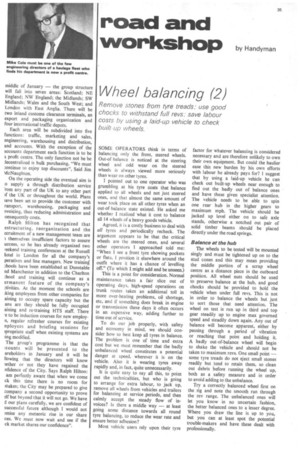road and workshop
Page 37

If you've noticed an error in this article please click here to report it so we can fix it.
by Handyman
Wheel balancing (2)
Remove Stones from tyre treads; use good chocks to withstand full revs; save labour costs by using a laid-up vehicle to check buift-up wheels.
SOME OPERATORS think in terms of balancing only the front, steered wheels. Out-of balance is noticed at the steering wheel and odd wear on the steered wheels is always viewed more seriously than wear on other tyres.
I pointed out to one operator who was grumbling at his tyre costs that balance applied to all wheels and not just steered ones, and that almost the same amount of wear took place on all other tyres when an out-of-balance state existed. He asked me whether I realized 'what it cost to balance all 14 wheels of a heavy goods vehicle.
Agreed, it is a costly business to deal with all tyres and periodically recheck. The argument appears to be that the critical wheels are the steered ones, and several other operators I approached told me: "When I see a front tyre showing pockets or flats, I position it elsewhere around the outfit where it has a chance of levelling off." (To which I might add and be unseen.) This is a point for consideration. Normal maintenance takes a fair slice out of operating days, high-speed operations on • trunk routes takes an additional toll in more over-heating problems, oil shortage, etc, and if something does break in engine or transmission these days it often occurs in an expensive way, adding further to time out of service.
To do our job properly, with safety and economy in mind, we should consider how to best keep all tyres in balance. The problem is one of time and extra cost but we must remember that the badly unbalanced wheel constitutes a potential danger at speed, wherever it is on the vehicle. Also it is wearing tyres away rapidly and, in fact, quite unnecessarily.
It is quite easy to say all this, to point out the technicalities, but who is going to arrange for extra labour, to jack up, remove all wheels from vehicles and trailers for balancing at service periods, and then calmly accept the steady flow of invoices? Is there a middle way — at least going some distance towards all round tyre balancing, to reduce the wear rate and ensure better adhesion?
Most vehicle users rely upon their tyre factor for whatever balancing is considered necessary and are therefore unlikely to own their own equipment. But could the haulier ease this new burden by his own efforts with labour he already pays for? I suggest that by using a laid-up vehicle he can check out built-up wheels near enough to find out the badly out of balance ones and have these given specialist attention. The vehicle needs to be able to spin one rear hub in the higher gears to maximum mph. The vehicle should be jacked up level either on to safe axle stands, otherwise a notched out pair of solid timber beams should be placed directly under the road springs.
Balance at the hub The wheels to be tested will be mounted singly and must be tightened up on to the stud cones and this may mean providing the middle portion of a scrap wheel centre as a distance piece in the outboard position. All wheel nuts should be used to preserve balance at the hub, and good chocks should be provided to hold the vehicle when under full revs. This is not in order to balance the wheels but just to sort those that need attention. The wheel on test is run up in third and top gear steadily up to engine max governed speed and steadily down again. Any out of balance will become apparent, either by passing through a period of vibration or reaching that point and holding it. A badly out-of-balance wheel will begin to shake the vehicle and should not be taken to maximum revs. One small point — some tyre treads do not eject small stones readily but tend to retain them, so clean out debris before running the wheel up, both as a safety measure and in order to avoid adding to the unbalance.
Try a correctly balanced wheel first on the rig and note the smooth run through the rev range. The unbalanced ones will let you know in no uncertain fashion, the better balanced ones to a lesser degree. Where you draw the line is up to you, but you can at least spot the potential trouble-makers and have these dealt with professionally.




































































































